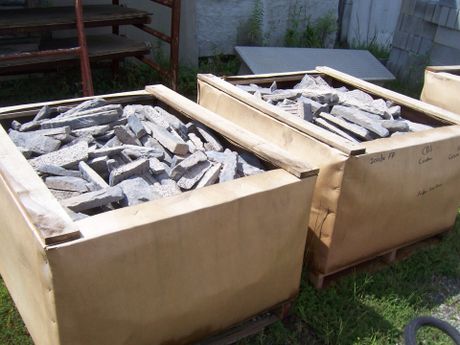Call Now:
(828) 926-0052
Surface Preparation
Wood, Paneling, Wallboard, Plywood and ICF Walls On an exterior surface, a weather resistant barrier of 15 lb. felt or better must be applied before installing metal lath. The barrier should be applied horizontally with the top layer overlapping the lower layer not less than 4 inches. Cover entire surface area with 2/5 lb. diamond wire mesh. Exterior applications require galvanized metal lath. Metal lath should be attached using galvanized nails or staples overlapping sides by not less than •” on sides and no less than 1” on Ends. Nails or staples should be 6” on center vertically and 16” on center horizontally into studs a minimum of 1”. Metal lath should be kept flat against the surface and the pockets of the mesh pointing upwards.
Masonry No surface preparation is necessary if the masonry surface (brick, block, or concrete) is clean. The hand-crafted stone can be applied directly to the surface. Painted, sealed or treated surfaces must be cleaned by sandblasting down to the original surface covered with metal lath using corrosion resistant concrete nails.
Metal Surface preparation is the same as for wood related preparation except use self–tapping screws on the metal lath that penetrates a minimum of 3/8” beyond the inside surface.
Scratch Coat
Use Type N or Type S mortar mix for installation. Follow mixing instructions on Bag to blend to a creamy paste. Apply a thin coat of mortar to completely cover the metal lathe. Scratch the surface with a rake or masonry tool to prevent having a smooth surface. The coating will provide a firm bonding surface for the hand-crafted stone. Some local codes require the scratch coat to dry for 48 hours before applying the stone. Check the local building codes prior to installation.
Installation
Depending on the job and type of stone, installation may begin at the top or bottom of the wall. Starting at the top will aid in keeping the stone clean. If applicable, corners should be installed first alternating short and long legs. Apply a •” thick layer of mortar to the back of the stone and press the stone firmly against the substrate using a wiggling action to insure a good bond. The mortar should squeeze out around the edges of the stone. Remove the excess mortar with a trowel and fill any voids on the stones exposed edges. A chalk line should be used to ensure the installation is level. Stagger the joint lines both horizontally and vertically for a finished appearance. If needed, stones may be cut or shaped with a diamond or carbide blade, mason’s trowel, hatchet or nippers. If mortar should get on the stone face, wait until it dries and clean with a stiff brush. NEVER USE WIRE BRUSHES, HARSH CLEANERS OR ACID TO CLEAN THE STONE. Do not use a sponge to wipe or remove the mortar as it may stain the surface of the stone. If a grout line is employed in the laying of the stone, typically •” to 1” spacing between the stones, a grout bag is used to fill in the joints. Fill the grout bag with mortar mixture, creamy paste desired and squeeze the small end into the joint area to be filled. Try to avoid getting grout on the edge of the stone. If this occurs, allow to dry and brush off with a small broom.
Finish Joints
Allow the mortar to start becoming firm and using a wooden striking tool, scrape away all excess grout in the joint and to force the mortar into voids. After working the joints use a hand broom to clean loose mortar from the joints and the stone face.
Quick Links
Contact Information
Address: 83 Jaybird Lane Waynesville, North Carolina 28785
Email: info@stoneworldofnc.com
Phone: (828) 926-0052
Business Hours:
- Mon - Thu
- -
- Friday
- -
- Sat - Sun
- Appointment Only
Closed Christmas Eve and Christmas Day






Limited Warranty: StoneWorld of NC, LLC carries a 20 year Limited Warranty when installed to manufacturer’s specifications, and on structures conforming to local building codes. Warranty is limited to the original purchaser. Warranty is limited to replacement of materials that are defective and does not include any labor charges. Warranty does not include for damage resulting from structure settlement, substrate or other wall movement, discoloration due to airborne contaminates or chemicals, normal weathering or oxidation is not covered by this warranty.

